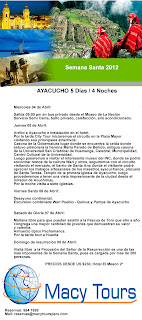Buenas Tardes amigos bloggeros:
A continuación les presentamos una excelente opcion para esta Semana Santa, La Merced - Oxapampa - San Ramón, un viaje inolvidable.
Un viaje donde visitaremos:
Plaza de Armas y calles principales de la Merced, posteriormente traslado al puente colgante de Kimiri construido en 1905 por los primeros pioneros, Perfil del Nativo Durmiente, llegaremos al mirador Villa
Progreso, donde observaremos la unión de los dos ríos
Chanchamayo y Paucartambo que forman el río Perene, observaremos el cultivo de la Naranja “VALENCIA”; Comunidad
Nativa Asháninca veremos su artesanía,
costumbres y danzas típicas.
Visita a la “Catarata de Bayoz” (120 m), descenso por el “Cañón de
Yurinaki” visita a la “Catarata
Velo de la Novia” (100 m.). Hora indicada retorno a la ciudad
de la Merced, llegada y visita a una fabrica de procesamiento de café de
exportación, degustación de café y licores típicos.
La Catarata del Tirol (40-min. de caminata) observando la
Flora y Fauna, también visitaremos El Mirador de La Cruz
(vista panorámica de La Merced).Visita al “Zhabeta Yard” (gran
variedad de plantas nativas, mariposas y animales silvestres)
Además tambien visitaremos la provincia de Oxapampa (Pasco), a lo largo del recorrido apreciaremos: El Distrito de San Luís de Shuaro, El Mirador de Mesapata (vista panorámica), llegada a
Oxapampa; Breve City Tours (visita a las Casas
Austro alemanas, Plaza de Armas, Iglesia Santa Rosa), exposición de Productos Lácteos
(FLORALP). También visitaremos el distrito de Chontabamba
donde ingresaremos al Tunqui Cueva
(Estalactitas Y Estalagmitas).
Con todas estas visitas creo que nuestros viajeros quedarán más que contentos, así que a viajar !!!
Macy Tours
Entradas populares
miércoles, 14 de marzo de 2012
viernes, 9 de marzo de 2012
martes, 25 de octubre de 2011
Full Day Paracas
An amazing experience shared with the group of students of Libertador Institute. We departured with the group around 5:30 from Chorrillos. All the students on time and ready to hit the road for a wonderful day at the Paracas bay.
Arrived to Paracas just on time to jump on the boat to departure to Ballestas Islands.
Here are some pictures of a hill on the way to the islands where you can see "El Candelabro" carved on the sand, figure carved just like Nazca Lines. Although the exact age of the" Candelabro" geoglyph is unknown, archaeologists have found pottery around the site dating back to around 200 B.C. This pottery likely belonged to the Paracas people, although whether they were involved in the creation of the geoglyph is not known. The reason for the Candelabro's creation is also unknown, although it is most likely a representation of the trident, a lightning rod of the god Viracocha, who was seen in mythology throughout South America. It has been suggested that the Candelabro was built as a sign to sailors.
During the visits it is not uncommon for the sea lions to approach the tourist boats and make spectacles for the visiting tourists. The sea lions are also responsible for a unique audio spectacle with their wolf-pack cries that echoes around the Ballestas and creates an effect of a 360 degree surrounding choir.
Right after this amazing experience visiting the Ballestas islands the group had some time off to get some lunch.
As soon as everybody was ready we all departure to the Paracas National Reserve to visit the Interpretation Center. The Interpretation Center explains how the bay used to look like hundreds of hundreds of years ago.
We departure from the Interpretation Center to one of the beaches in the reserve called Lagunillas and stop there for some pictures. The group could appreciate how the earthquake of 2007 took some of the boats all the way to the desert.
Our next stop "The red Beach" named this way due to the sand's volcanic origin. The sand is no renewable so the visitors are not allowed to take rocks or sand from the beach.
Suscribirse a:
Comentarios (Atom)













